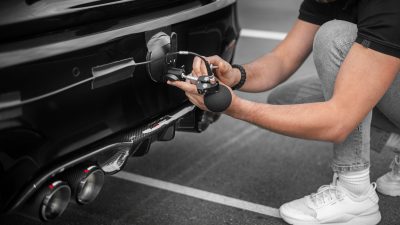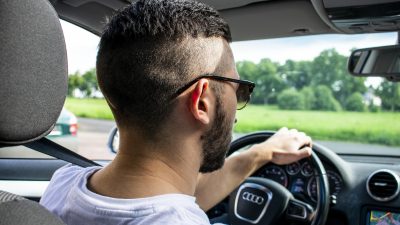Driving at night comes with its unique challenges.
Driving at night can be both exhilarating and daunting. The roads may seem quieter, but the risks increase significantly when you’re behind the wheel in the dark. Reduced visibility, glare from oncoming vehicles, and tiredness can all contribute to a more dangerous driving experience. But don’t worry – by following some simple, practical tips, you can ensure your safety and keep your journey smooth. Whether you’re on a long road trip or just heading out for a short drive, these essential tips will make all the difference.
Keep a Safe Distance
One of the most crucial rules when driving at night is to maintain a safe distance from the car in front of you. At night, your vision is reduced, which means your reaction time is slower. You need extra space to stop if the car ahead of you suddenly brakes. Following the four-second rule is recommended, which means you should pass a road sign four seconds after the car ahead of you at 55 miles per hour. Keeping a safe distance also prevents your headlights from blinding the driver in front of you.
Don’t Look at the Lights of Oncoming Cars
The headlights of oncoming cars can be blinding, distracting, and dangerous. Bright lights can disturb your concentration and reduce your ability to see clearly. Instead of staring at the lights, look to the right edge of the road. This will help you stay focused without being distracted. If you’re being blinded by the car behind you, adjust your rearview mirrors to reduce the glare.
Clean and Adjust Your Mirrors
Your mirrors play a critical role in nighttime driving. Dirty mirrors can reflect the light from other vehicles in a scattered way, causing unnecessary glare. Keep your mirrors clean and adjust them to the best position to minimize glare. If your rearview mirror has an auto-dimming feature, make sure it’s working properly, or adjust it manually.
Adjust Your Headlights
Headlights are essential when driving at night, but they can be ineffective if not correctly adjusted. Dim or improperly angled headlights can decrease your visibility and increase glare for other drivers. Regularly check your headlights and ensure they’re clean, especially if you’re embarking on a long trip. Headlight polishers are available to clean off dirt and dust, which may impair their performance.
Take Regular Breaks
Driving for long periods at night can be mentally and physically exhausting. It’s important to stop regularly for rest, light snacks, and even a quick nap if needed. Your eyes need rest, and so does your body. Stretching your muscles and rehydrating can help you stay alert and refreshed, preventing driving fatigue that can be dangerous on long journeys.
Avoid Two-Lane Highways
Two-lane highways can be more challenging to drive on at night due to sharp curves and sudden hills. The reduced lighting and glare from oncoming cars make the experience more stressful. Whenever possible, choose multi-lane highways that are better lit and have fewer potential hazards.
Use Fog Lights – Even When It’s Not Foggy
Fog lights aren’t just for foggy weather; they can be helpful when driving at night. When used in combination with low or high beams, fog lights help illuminate the road more effectively without blinding other drivers. However, always ensure you’re not using them in a way that could distract or hinder other drivers’ vision.
Watch Out for Animals
Animals, particularly deer, can be a serious hazard when driving through rural or wooded areas at night. They often appear suddenly on the road, making it difficult to react in time. When driving at night, slow down, and if you spot animals’ glowing eyes, avoid swerving. The safest option is to brake gently and stop if necessary.
Use Anti-Reflective Glasses
If you wear glasses, it’s essential to have a pair with anti-reflective lenses for night driving. Ordinary glasses can create a glare from oncoming headlights, reducing your visibility. Alternatively, wearing contacts or getting your vision checked regularly can also help. Glare tends to become more problematic with age, so staying on top of your eye health is vital.
Don’t Drive Alone
Fatigue can set in quickly during long nighttime trips. Having a passenger with you not only provides company but can also be a lifesaver. They can help with tasks like answering the phone, changing the radio station, or even driving if you get too tired. Avoid distractions, though – a lively conversation is fine, but don’t let it take your focus off the road.
Minimise Dashboard Brightness
A bright dashboard can hinder your vision at night. The lights from your dashboard can make it more difficult for your eyes to adjust to the darkness ahead. Dim the dashboard lights to make it easier to focus on the road, and avoid using electronic devices like phones or tablets, as their screens can create further glare.
Use GPS for Navigation
At night, navigating unfamiliar roads can be tricky. A GPS is invaluable for providing you with road awareness and helping you anticipate turns or exits long before they come into view. It gives you better situational awareness, allowing you to focus on driving safely rather than figuring out where to go next.
Be Cautious When Passing Large Vehicles
When passing oversized vehicles, such as trucks or road service vehicles, exercise caution. These vehicles are often longer than they appear, and their size can make it difficult to judge how much space you need. Only pass large vehicles in well-lit areas and ensure you have enough time and distance to do so safely.
Don’t Speed at Night Finally, the most important rule when driving at night is to avoid speeding. Nighttime driving is more challenging, and speeding only increases the risk of accidents. Stay within the speed limits, or even reduce your speed in low-visibility or bad weather conditions. Take your time and enjoy the journey safely.




